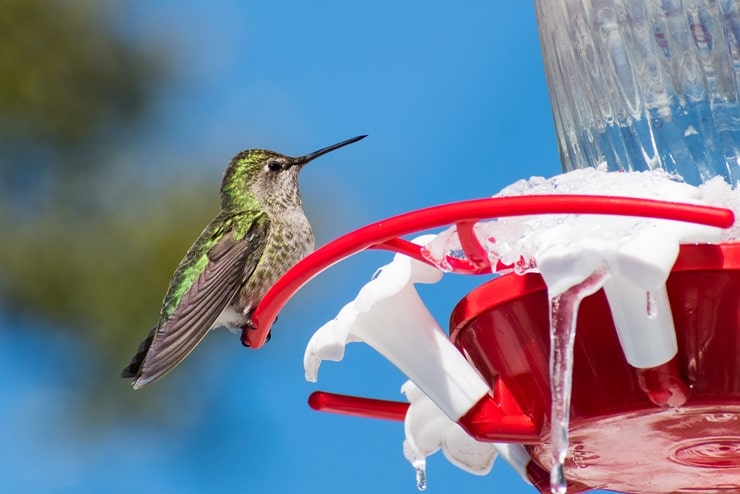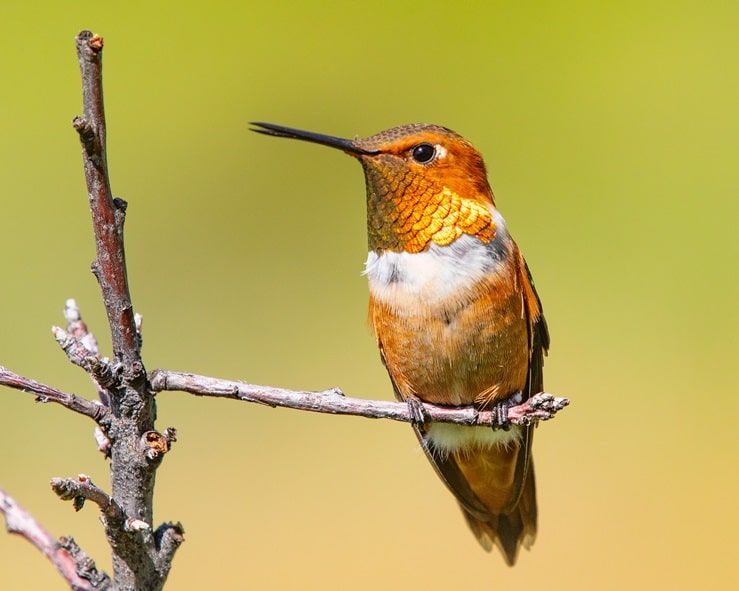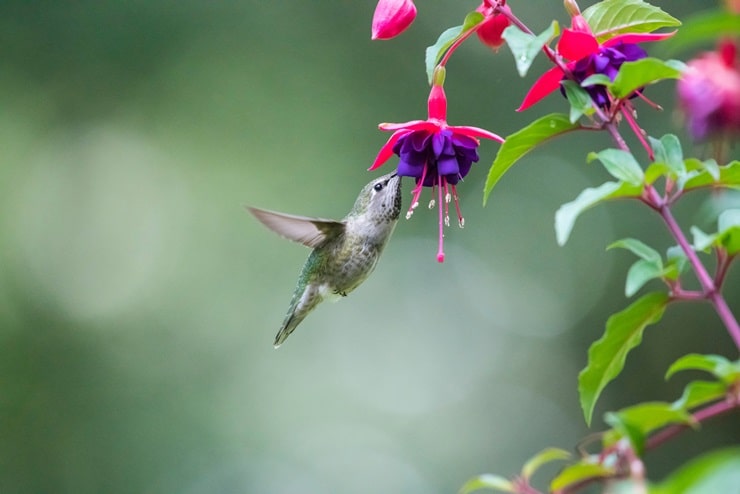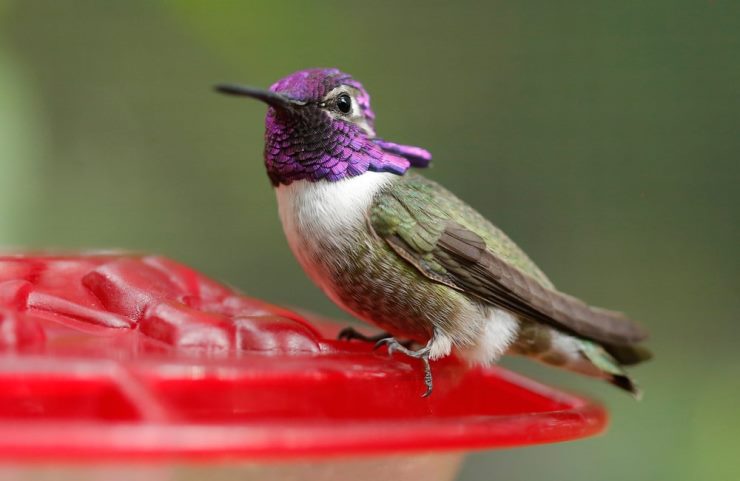Alaska is nothing like the tropical environments that hummingbirds prefer, but that doesn’t mean that these brave little fliers won’t pop into the state to hunt for food now and then.
Hummingbirds are intrepid travelers. They fly miles and miles, across states and even the ocean without stopping. The most common hummingbird in Alaska is the rufous hummingbird. They’ve been recorded as traveling all the way from Florida to Alaska in one season!
While you probably won’t see any of these birds during the winter, it’s possible to see them starting in spring and through fall.
Here is the list of species of hummingbirds in Alaska:
- Anna’s Hummingbird
- Rufous Hummingbird
- Calliope Hummingbird
- Costa’s Hummingbird
4 Types of Hummingbirds in Alaska
Hummingbirds visit every part of North America, with just a few that pop up to visit Alaska. Some lists claim that ruby-throated hummingbirds visit Alaska, but it’s likely that people have seen Anna’s, rufous, or Costa’s hummingbirds, which can look similar.
1. Anna’s Hummingbird

- Scientific name: Calypte anna
- Size: 3.9 inches long
- Weight: 0.1-0.2 ounces
- Wingspan: 4.7 inches
If you live along the Pacific coast, then no doubt you’ve seen the stunning Anna’s hummingbird. They’re one of the most common species in the region and they live there all year long. They’ll also travel inland a bit during the breeding season and some will migrate to Mexico during the non-breeding season.
Look for the greenish-gray birds with iridescent feathers. Males have reddish-pink chins and heads.
When they’re breeding, the males will swoop down up to 130 feet, making a buzzing noise with their tail feathers in an attempt to impress the females.
These birds are bold and curious and will come right up to humans to check them out. They’ll eat at feeders, snatch insects, and suck the sap of tubular flowers.
When Do They Arrive In and Leave Alaska?
If you live in Alaska, look for these pretty birds during the summer.
2. Rufous Hummingbird

- Scientific name: Selasphorus rufus
- Size: 2.8-3.5 inches long
- Weight: 0.1-.02 ounces
- Wingspan: 4.3 inches
Rufous means “reddish” and that’s what these birds are. When the sunlight hits them, they glow like a lump of burning coal, with a reddish back and a vivid red throat. The females have a little bit of green on their tails and flanks, plus a little spot of orange on their throats.
Even though these birds might just be visiting an area as they migrate, they’re fierce defenders of the area they are in. They will tirelessly chase off any hummingbird that dares come near. They’ll even chase off bigger birds of other species and they’ll dive-bomb humans who come too close to their feeder or nest.
Like ruby-throated hummingbirds, they’re incredibly agile and will feed from feeders and tubular flowers, as well as snatch insects from the air or spider webs. They live in backyards, forests, meadows, and parks.
In the spring, they leave to their breeding grounds on the west coast where they stay from April to July.
When Do They Arrive In and Leave Alaska?
These hummingbirds aren’t extremely common in Alaska, but they’re appearing in the state more and more often. They’re the most commonly seen species in the state.
3. Calliope Hummingbird

- Scientific name: Selasphorus calliope
- Size: 2.8-3.9 inches long
- Weight: 0.07-0.1 ounces
- Wingspan: 4.3 inches
Calliope hummingbirds are common in the Pacific Northwest, California, parts of the west, and Canada.
They breed in western Canada, Alaska, Washington, California, Nevada, Idaho, Montana, Wyoming, and parts of Utah and they spend the non-breeding season in Mexico.
The males of these beautiful birds have magenta feathers on their throats and both females and males have iridescent green feathers on their backs. The male courts the female by diving in an acrobatic u-shape while making a buzzing sound with his tail feathers. They breed from April to June.
While they will eat from feeders, they tend to be a bit timider than some other hummingbirds. They aren’t afraid of other birds, though. They’re even known to chase away red-tailed hawks.
They’ll eat the sap from flowers, but they’re also fond of the sap on trees left by sapsuckers and they’ll also eat insects and spiders.
When Do They Arrive In and Leave Alaska?
These tiny birds, the smallest hummingbirds in North America, might arrive in the summer and stick around through fall, but they’re vagrant and rare.
4. Costa’s Hummingbird

- Scientific name: Calypte costae
- Size: 3.5 inches long
- Weight: 0.1 ounces
- Wingspan: 4.3 inches
These compact little birds appear to have a sort of hunched posture. The adult males have a purple crown and neck, with a green back and sides.
These birds feed on chuparosa and ocotillo, as well as insects and at feeders. They live in desert areas of the American west. You mostly find them in Southern California, Nevada, parts of Utah, and a little bit of New Mexico, but they do migrate so you might see them as far east as Florida and as far north as Alaska.
They breed in the interior of the country but stay on the coast year-round. During the non-breeding season, some might visit coastal Mexico.
These birds are shyer and will avoid feeders if bolder, more aggressive species are there.
When Do They Arrive In and Leave Alaska?
This vagrant species is a rare visitor and only occasionally spotted in Alaska, usually in the summer.
How to Attract Hummingbirds
Hummingbirds are a New World group of birds, meaning they only live in South, Central, and North America. Within North America, there are 16 native species of hummingbirds and a few visiting species.
If you want a sure-fire experience of drawing birds to your yard, try hanging up a hummingbird feeder. Hummingbirds travel far and wide to find good food and they’ll stop by and eat the food in your feeder, giving you an exciting show in the process.
To attract hummingbirds to your yard, pick feeders that have a little perch so you can observe them holding still as well as in flight.
Contrary to common belief, the feeder doesn’t have to be red. These birds don’t care about the color, they just want a nice meal. You can grab a beautiful feeder with perches from Bolite. Don’t die the nectar, either. Clear nectar is totally fine.
You can also use pre-made nectar to attract them. Just be sure to change the nectar frequently and wash the feeder out with hot water and soap. When it’s really hot, you should change your feeder daily. During cooler weather, once a week is fine.
Feeders left uncleaned develop a mold that can kill hummingbirds.
Some experts also recommend that you put your feeders away in regions that get cold during the winter so you don’t accidentally entice tropical birds to stick around during the winter.
You should also plant stuff like firebush, fuchsia, honeysuckle, cardinal flowers, fire pink, wild bergamot, columbine, red buckeye, trumpet vine, and powder puff trees. Hummingbirds love these.
Other Species of Birds in Alaska:
Woodpeckers in Alaska
Owls in Alaska
